Rochas La Rose Eau de Jeunesse (1949) {Perfume Review} {Smell-The-Roses-Till-Valentine's Day Challenge - Day 22}
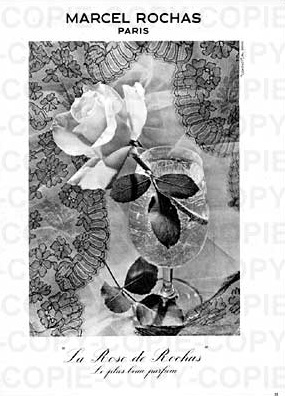
This review ought perhaps to go under the heading of "antiquing" as we have only sparse information available at this point on this relatively little known fragrance by Marcel Rochas called Eau de Jeunesse La Rose (Youth Water, The Rose, in that order). It was a find and we decided to include it in our Smell-The-Roses-Till-Valentine's Day Challenge Series.
What we know is that La Rose was created by perfumer-composer Edmond Roudnitska and launched in 1949, the same year Caron released Or et Noir and Rose. The perfumer himself recounts in a 1993 interview published on the site Art et Parfum owned by his son Michel Roudnitska - who is also a perfumer - that it was then the pretext to a lavish launch party that took place at the rose garden of L'Hay-Les-Roses, near Paris.
This rose garden was bought in 1894 by Jules Gravereaux and landscaped in 1899 by Edouard André. They claim that it was the first rose garden ever to see the light of day in the Western world, but this is somewhat of an exaggerated claim as Joséphine de Beauharnais is known to have helped found a roseraie or rose garden at the Jardin des Plantes in 1805 and was herself the founder of an important rose conservatory at Malmaison. Rose gardens have existed since times ancient. L'Hay-Les-Roses is more cautiously characterized sometimes as the first modern rose garden.
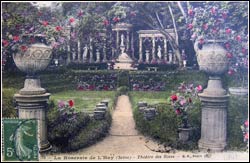
In 1905, a Théâtre de la Rose or Theater of the Rose was added to the garden that allowed for performances to take place, which contributed to the popularity of this elegant site during the Belle Epoque. The Rose Theater no longer stands as it was demolished in 1970.
Edmond Roudnitska tells us that the launch party was accompanied by a music by Henri Sauguet.
The bottle is the trademark voluptuous feminine form reported to replicate Mae West's curves. The cap of our bottle appears to be an early plastic, maybe bakelite, with the words Marcel Rochas Paris forming a circle on a pink painted background. The cap is black. The outer packaging was at some point made of a minimalist pink cardboard and at another featured the Rochas lace on a pink background....
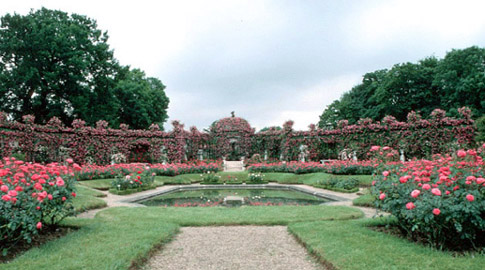
As far as the scent is concerned, it makes you think both of the freshness and light chypre quality of Diorella and the darker plummy fruity character of Femme, as if it were in some respect, a cross between the two. Like Voleur de Roses, but in a very different manner, it associates a rose note with a distinctive plummy one. The rose is slightly metallic, discreetly powdery resting on a light, luminous Chypre background while letting out some ambergris accents. The dry-down is sweet and amber-y and slightly fruity with a little rose lipstick impression.
The perfume is rather fleeting today. Its personality is simple, young, fresh, almost sporty yet feminine, with just those nuances that place it in a different period where oakmoss and ambergris were much more ubiquitous. The plum seems to have "turned" as it is a bit sour-smelling and woody; we doubt that it was meant to smell this way in the beginning.
La Rose feels for the most part modern through the simplicity of its composition, its tendency to suggest transparency and finally its unmistakable fresh character. Its name indicates that it was meant to illustrate a youthful theme. The light concentration we have gives the impression that it was meant to be worn in a casual manner.
It came three years after Ma Griffe by Carven which is considered to be the first perfume marketed to young women wanting to assert a style different from that of their mothers', a little bit like the social revolution that was when children were not considered just as small, immature adults, but children in their own rights.
La Rose Eau de Jeunesse is touching today as it seems to offer the scent of young women from a different era showcasing now an unlikely combination of old-school oakmoss and rose.
Diorella by Edmond Roudnitska was created later in 1972 for fresh young women but we know that he had been working on the formula for Diorella for 20 years. It may well be that La Rose was an early "draft" of Diorella while drawing on the popularity of Femme (1944) and its candied plum together with the addition of a classic rose note. A flanker before the letter in other words and perhaps one of the first light versions of a perfume, at its core. It was discontinued in 1973.
References: Art et Parfum, Toutenparfum, Michael Edwards, Parfums de Légende, Roseraie du Val de Marne, Okadi







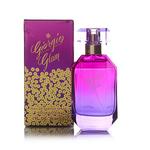

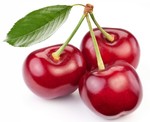
i used to wear La Rose -- my mother bought me a bottle of it. i loved it, and was brokenhearted when i found that i could not buy anymore of it later. it was beautiful. i am going to go sniff diorella now.
I've seen it online a few times recently. It probably would smell not as fresh as when you knew it.
Ah, the transiency of things...I hope you find another perfume you love.